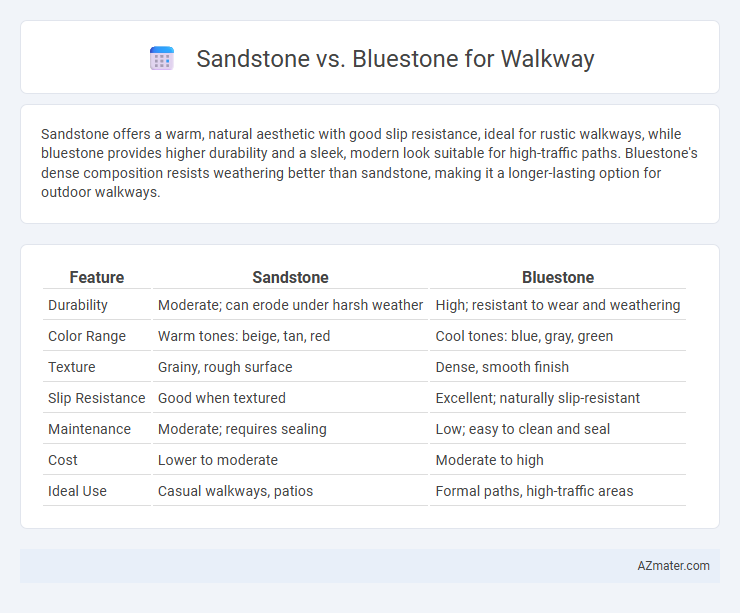Sandstone offers a warm, natural aesthetic with good slip resistance, ideal for rustic walkways, while bluestone provides higher durability and a sleek, modern look suitable for high-traffic paths. Bluestone's dense composition resists weathering better than sandstone, making it a longer-lasting option for outdoor walkways.
Table of Comparison
| Feature | Sandstone | Bluestone |
|---|---|---|
| Durability | Moderate; can erode under harsh weather | High; resistant to wear and weathering |
| Color Range | Warm tones: beige, tan, red | Cool tones: blue, gray, green |
| Texture | Grainy, rough surface | Dense, smooth finish |
| Slip Resistance | Good when textured | Excellent; naturally slip-resistant |
| Maintenance | Moderate; requires sealing | Low; easy to clean and seal |
| Cost | Lower to moderate | Moderate to high |
| Ideal Use | Casual walkways, patios | Formal paths, high-traffic areas |
Introduction to Sandstone and Bluestone Walkways
Sandstone walkways offer a warm, earthy appearance with natural variations in color and texture, making them ideal for creating rustic, inviting outdoor paths. Bluestone walkways, composed primarily of dense sandstone with high quartz content, provide a smooth, durable surface with bluish-gray hues that complement modern landscaping designs. Both materials are slip-resistant and weather well, but sandstone is softer and more porous, requiring more maintenance compared to the harder, more resilient bluestone.
Aesthetic Appeal: Sandstone vs Bluestone
Sandstone offers a warm, earthy aesthetic with natural hues of tan, red, and gold, creating a rustic and inviting walkway appearance. Bluestone features a cooler palette of blues and grays, providing a sleek, modern look with subtle texture and smooth finish. The choice between sandstone and bluestone significantly influences walkway ambiance, aligning either with natural warmth or contemporary elegance.
Durability and Weather Resistance Comparison
Sandstone offers moderate durability with relatively soft mineral composition, making it prone to erosion and chipping in harsh weather conditions. Bluestone, composed mainly of dense feldspathic sandstone, exhibits superior weather resistance and hardness, maintaining structural integrity under freeze-thaw cycles and heavy foot traffic. For walkways exposed to varying climates, bluestone provides longer-lasting performance and lower maintenance compared to sandstone.
Slip Resistance: Safety Factors for Walkways
Sandstone offers moderate slip resistance due to its natural grainy texture, making it a safe option for walkways in dry conditions; however, it can become slippery when wet or covered with algae. Bluestone, known for its dense and slightly rough surface, provides superior slip resistance, enhancing safety for walkways exposed to moisture or heavy foot traffic. Selecting bluestone for walkways significantly reduces the risk of slips and falls, especially in areas prone to rain or dampness.
Cost Differences: Sandstone vs Bluestone
Sandstone walkways generally cost less than bluestone due to the lower extraction and processing expenses, with sandstone prices ranging from $5 to $15 per square foot compared to bluestone's $15 to $30 per square foot. Bluestone's higher cost reflects its durability, denser composition, and aesthetic appeal, which contribute to increased material and installation expenses. When budgeting for a walkway, the cost difference between sandstone and bluestone can significantly impact the overall project price, making sandstone a more budget-friendly option for large areas.
Maintenance Requirements and Longevity
Sandstone walkways require regular sealing and cleaning to prevent weathering and moss buildup, with moderate durability that can last 10-20 years depending on climate conditions. Bluestone is more resilient against chipping and staining, demanding less frequent maintenance while offering superior longevity of 20-30 years or more in outdoor settings. Choosing between sandstone and bluestone hinges on balancing maintenance efforts against desired lifespan and environmental exposure.
Installation Process and Complexity
Sandstone walkways require careful leveling and compaction of the base due to the stone's natural variability, with installation involving precise cutting to fit irregular shapes. Bluestone, known for its uniform thickness and hardness, allows for a more straightforward, consistent installation process with easier alignment and reduced need for adjustments. Both materials demand proper joint filling and sealing to ensure durability, but sandstone's softer composition often increases complexity and labor costs compared to bluestone.
Environmental Impact and Sustainability
Sandstone walkways offer a more sustainable option due to their natural abundance and lower energy-intensive extraction processes compared to bluestone, which often requires quarrying that disrupts ecosystems significantly. Bluestone, while durable and dense, typically involves higher carbon emissions during mining and transportation due to its heavier weight and longer supply chains. Choosing locally sourced sandstone reduces the environmental footprint by minimizing transportation energy use and promoting responsible quarrying practices, enhancing overall sustainability for walkway projects.
Popular Styles and Design Options
Sandstone walkways offer a warm, natural palette with earthy tones, ideal for rustic and traditional garden designs, featuring textured surfaces that provide slip resistance. Bluestone is prized for its cool blue-gray hues and smooth finish, fitting modern and contemporary outdoor spaces, often cut into irregular or geometric shapes for versatile design patterns. Both materials support various layouts--from flagstone patterns to cobblestone effects--allowing customization to complement landscaping themes and enhance curb appeal.
Choosing the Right Stone for Your Walkway
Sandstone offers a warm, natural appearance with excellent slip resistance, making it ideal for walkways in dry climates, while bluestone provides superior durability and a sleek, modern look suited for areas with heavy foot traffic and varying weather conditions. Consider the hardness rating and porosity of each stone; sandstone is softer and more porous, requiring more maintenance, whereas bluestone's dense composition enhances longevity and reduces staining. Selecting the right stone depends on your walkway's exposure to elements, aesthetic preferences, and maintenance capacity to ensure both functionality and visual appeal.

Infographic: Sandstone vs Bluestone for Walkway
 azmater.com
azmater.com